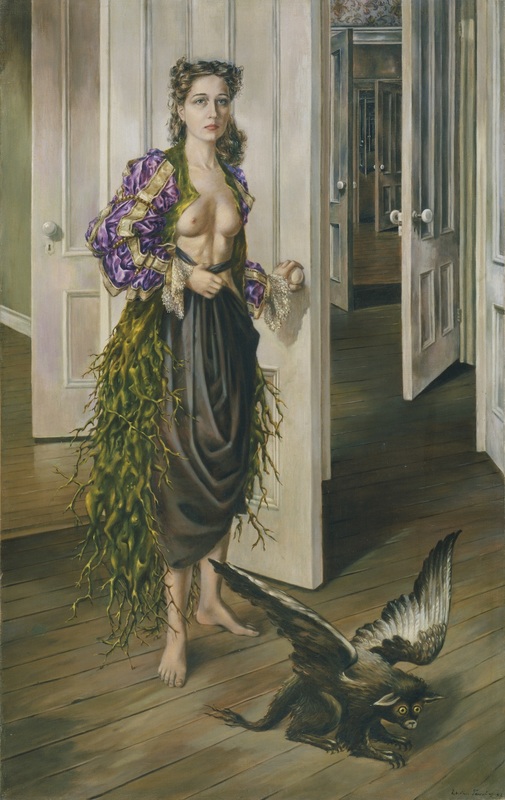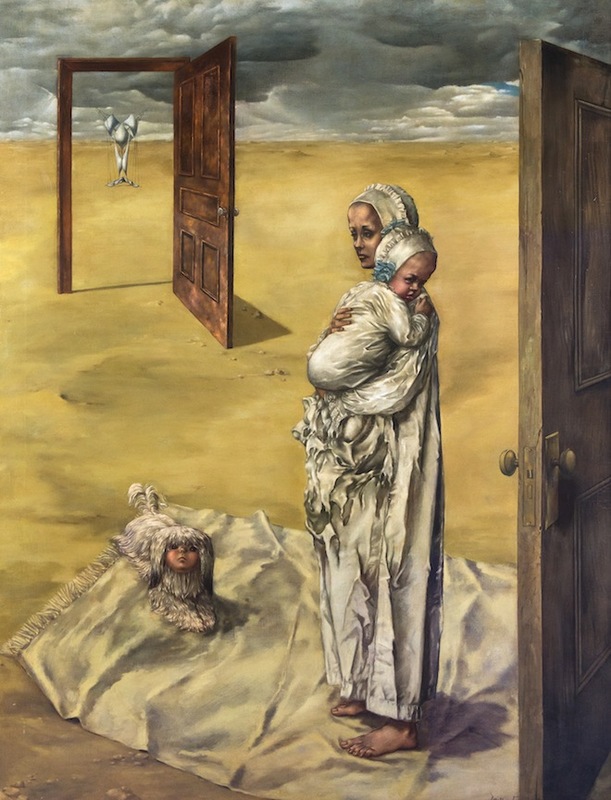Works
The idea of surrealism is to create art not from what you actually see but what your subconscious sees, painting dreams instead of photographs, with a specific emphasis on the personal subconscious surrealism comes from romanticism. Dorothea, while not being a surrealist for her whole career, was a surrealist for a significant portion and like other women in the genre worked hard to transform herself from a muse to a master. She plays on this femininity in a lot of her paintings, in Birthday the female form is displayed both by Dorothea and the plant-like figures protruding from her jacket. The title which was pitched by Max was meant to portray Dorothea's shift to surrealist from her previous realist background, her birth into a new art form. She used her art as a weapon and rather than fall into traditional gender roles she made purposeful efforts to defy what was expected of her and her art. In Birthday even though she is naked, there is a certain power in how she looks into the viewer's eyes and almost says "Here I am," she acknowledges the sexual aspect and moves past it. She describes it in Between Lives: An Artist and Her World, the 'meaning' behind her painting.
"At first there was only that one picture, a self-portrait. It was a modest canvas by present-day standards. But it filled my New York studio, the apartment’s back room, as if it had always been there. For one thing, it was the room; I had been struck, one day, by a fascinating array of doors—hall, kitchen, bathroom, studio—crowded together, soliciting my attention with their antic planes, light, shadows, imminent openings and shuttings. From there it was an easy leap to a dream of countless doors."
Tanning, Dorothea. Between Lives: An Artist and Her World. 1st ed. New York; London: W.W. Norton, 2001. pg. 62
In other paintings, she portrayed the roles of women and in particular young girls in a completely new way, her first foray into surrealism she depicts to young women in a long corridor semi-covered in flowers and semi-nude. The idea of semi-nude young girls in the 1940's would have been jarring and Tanning wanted it to be, she wanted to show femininity in a way that wasn't explicitly sexual but rather factual. The women in her works were authentically women and Dorothea while creating surrealist art was attempting to leave them in real. In all her art she does this, she applies this almost feminist idea of what women could be, are, instead of what they were supposed to be. We see this later in her career when she ventures into sculpture and depicts naked female cloth forms protruding from furniture, and see it even in her poetry.
The painting Maternity is another example of her surrealism and is probably the most famous painting to come from Dorothea's time in Sedona, based on a poem in French by Max Ernst called Maternité (translated below.) The painting once again features women this time instead of naked women she depicts a mother and what appears to be her daughter, next to them is a dog, potentially modeled after her own dog Kachina, with what appears to be a female face. The trio is the desert between two doorways, which to me at least envokes the idea of motherhood being a lonesome place in current society.
Velvet in space
decorative rain bursts
and a given time
The summer of previous generations
near Jerusalem or Philadelphia
irresponsible
a glass of bitterness
two derisions of almost terrible majesty
our greatness our curse our weight
In white dress and glorified by putrid tears
with childlike words and liquor
of popular belief
of popular belief like you and me
by the satisfied authority
and the gloomy fertility
—or are we going to leave in silence
Strolling through the door...
—Max Ernst, 1946

